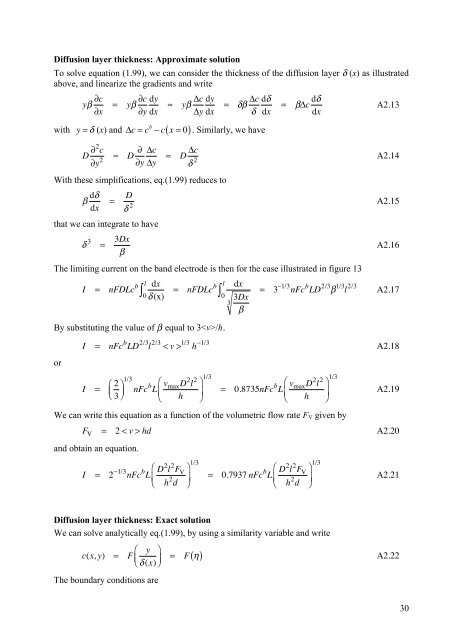koff - LEPA
koff - LEPA
koff - LEPA
Create successful ePaper yourself
Turn your PDF publications into a flip-book with our unique Google optimized e-Paper software.
Diffusion layer thickness: Approximate solution<br />
To solve equation (1.99), we can consider the thickness of the diffusion layer δ (x) as illustrated<br />
above, and linearize the gradients and write<br />
y! !c<br />
!x<br />
!c dy<br />
= y!<br />
!y dx<br />
#c dy<br />
" y!<br />
#y dx<br />
#c d"<br />
= "!<br />
" dx<br />
with y = ! (x) and !c = c b " c( x = 0).<br />
Similarly, we have<br />
D !2 c<br />
!y 2<br />
" D ! #c<br />
!y #y<br />
= D #c<br />
! 2<br />
With these simplifications, eq.(1.99) reduces to<br />
! d"<br />
dx<br />
= D<br />
" 2<br />
that we can integrate to have<br />
= !#c d"<br />
dx<br />
A2.13<br />
A2.14<br />
A2.15<br />
! 3 = 3Dx<br />
" A2.16<br />
The limiting current on the band electrode is then for the case illustrated in figure 13<br />
I = nFDLc b l dx<br />
0 ! (x)<br />
! = nFDLc b l<br />
0<br />
dx<br />
3<br />
By substituting the value of β equal to 3/h.<br />
or<br />
3Dx<br />
"<br />
= 3 –1/3 nFc b LD 2/3 " 1/3 l 2/3<br />
! A2.17<br />
I = nFc b LD 2/3 l 2/3 < v > 1/3 h !1/3 A2.18<br />
I =<br />
! 2$<br />
"<br />
#<br />
3%<br />
&<br />
1/3<br />
nFc b L vmaxD 2 l 2 !<br />
#<br />
"<br />
h<br />
$<br />
&<br />
%<br />
1/3<br />
!<br />
#<br />
"<br />
= 0.8735nFc b L v maxD 2 l 2<br />
We can write this equation as a function of the volumetric flow rate FV given by<br />
h<br />
$<br />
&<br />
%<br />
1/3<br />
A2.19<br />
F V = 2 < v > hd A2.20<br />
and obtain an equation.<br />
"<br />
$<br />
#<br />
I = 2 !1/3 nFc b L D2 l 2 F V<br />
h 2 d<br />
%<br />
'<br />
&<br />
1/3<br />
"<br />
$<br />
#<br />
= 0.7937 nFc b L D2 l 2 F V<br />
Diffusion layer thickness: Exact solution<br />
We can solve analytically eq.(1.99), by using a similarity variable and write<br />
! y $<br />
c(x, y) = F<br />
"<br />
#<br />
! (x) %<br />
&<br />
The boundary conditions are<br />
h 2 d<br />
%<br />
'<br />
&<br />
1/3<br />
A2.21<br />
= F ( ! ) A2.22<br />
30


